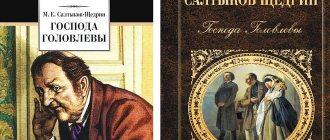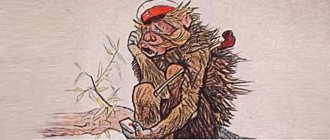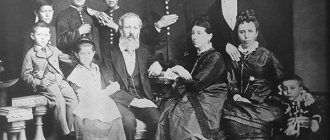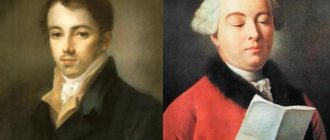- Essays
- On literature
- Other
- Satire and humor of Saltykov-Shchedrin
The works of Mikhail Evgrafovich Saltykov-Shchedrin are varied in their style, but the works of the satirical genre brought him real recognition. It was the satirical orientation of his works that put him on a par with world-famous writers - Aesop, Mark Twain, Francois Rabelais, Jonathan Swift.
The main direction of his satirical works is a sharp criticism of general social problems in Russia at that time. In their works, Saltykov-Shchedrin satirically ridiculed all the vices of the autocratic serfdom regime of the 19th century. The object of ridicule was the way of life and wild customs of society, the moral and physical “decay” of landowners, the vegetation of ordinary people, the development of culture and much more. But to a greater extent, the writer’s satire was aimed at two vectors of society - the ruling autocracy and the common people, criticizing both the oppressors for their tyranny and cruelty, and the oppressed for their meekness and fear.
The satire of Saltykov and Shchedrin is imbued with revolutionary sentiments and liberation theories. He actively intervenes in the events described, imbuing his works with a journalistic focus.
As a continuer of Gogol's traditions, Mikhail Evgrafovich tries to portray the monstrous reality of what is happening in an extremely critical light. The author skillfully finds his own style of satire - fantastic grotesque. This gives him the opportunity to give the images a symbolic and absurd character. The characters acquire implausible qualities that help to perfectly reveal the essence of the situation being described.
A great creative success is the writer’s ability to express his critical attitude towards life in the country through fairy tales. By choosing this form of storytelling, Saltykov-Shchedrin skillfully adds a new, brighter meaning to the ancient form of folk art. The writer is excellent at expressing himself in allegorical Aesopian language to depict the complete meaninglessness of what is happening. His tales are a formidable and instructive satire for all the troubles and sorrows that happen around.
The tales of Saltykov and Shchedrin “for children of a fair age” are a protest of the patriotic author against the surrounding outrage, a unique way of combating it. In his tales, as expected, there is edification for the reader. The main characters are animals, but in a strange way they resemble people! They live the same ordinary life as people, doing simple everyday things: reading the press, working in departments, getting an education in cadet corps and paying taxes. This one adds a special whimsicality to Satykov’s “Fairy Tales” - Shchedrin. The writer depicts the life of animals in the smallest detail, giving the reader the opportunity to realize that he is conveying the current problems of Russia at the end of the 19th century.
In his works, the writer very actively uses the technique of “speaking surnames”. His characters are truly alive, not just made up. He copied many images and characters from close and dear people - his mother and brothers.
Saltykov-Shchedrin's ability to express his thoughts with the help of allegory allowed him to bypass the strict court of censors in a roundabout way. He could express his revolutionary thoughts without hiding. The phrases and ideas were so disguised that not everyone could recognize the true theme of the work. This is especially true for fairy tales. Since fairy tales are, as a rule, reading material for children, few people will look for the truth in them, simply enjoying reading them.
It is very difficult to classify works into any genre. Saltykov-Shchedrin masterfully wields all styles, intertwining them into one of his own, special narrative systems, opening up new spaces for imagination for the readership. This is what impresses and inspires readers. The works of Saltykov and Shchedrin are still quite popular and relevant today.
Option 2
Saltykov-Shchedrin is best known as a satirical writer. In his works, he ridiculed the very vices of his contemporary society, from which it has not yet gotten rid of. But I am sure that his work was not in vain, and his satirical tales are still relevant today.
Everyone knows his wise minnow and idealistic crucian carp or philanthropic eagle, for example. Also in animals, birds and fish, which acted like people in his stories, he showed human vices. But sometimes even the vices themselves became characters. In the fairy tale “Virtues and Vices” there live Flattery, Honesty, Adultery... They have their own old people who, for example, believe that vices should proudly carry their banner, and there are also young people who think that they can pretend to be virtuous in order to enter a good home. These almost abstract, but such living characters have communication, relationships, and their own habits. Virtues are humiliated, they try to throw away the “trick” in order to live in gold - no worse than vices. Saltykov-Shchedrin's tales are precisely aimed at, on the one hand, surprising the reader, and on the other, showing him familiar situations.
Writers and ordinary people act less often in stories. For example, his deceiving newspaperman, in the story of the same name, complains that the truth has fallen in price. And the gullible reader, through the fault of the deceiver, ends up in prison, where within a day he catches an illness from which he immediately dies. And the newspaperman lives happily ever after!
In the story “Liberal” the hero is greeted with joy and allowed to carry out reforms, but only with “permission”. Not all at once! And the liberal abandons his principles step by step.
Saltykov-Shchedrin criticized society, state institutions - in fact, officials. All this is allegorical, but accessible. The author uses various literary devices, for example, hyperbole.
Satire permeated the entire work of Saltykov-Shchedrin, his name is completely associated with it in Russian literature. I personally like this author’s fairy tales, but it’s difficult to read too many of them at once. At least for me.
Humor in the works of Saltykov-Shchedrin
M.E. Saltykov-Shchedrin is a great Russian writer. His creativity is diverse. From the pen of the author, poetic and prose works were published. Even in his youth, Mikhail Evgrafovich began to compose satirical poems. Through them he expressed his disapproval of this or a phenomenon. In order to avoid censorship, the writer uses the technique of allegory.
Fairy tales occupy a special place in the series of works of Saltykov-Shchedrin. It is fairy tales that are the satirical pinnacle of the author’s creativity. By creating fairy-tale images, the writer gives his characters a satirical meaning. Thus, through satire and allegory, Saltykov-Shchedrin tries to convey to the reader the depth of social phenomena. Animal images have long been used in fables and fairy tales. The author used this well-known technique. Through images of animals endowed with the most disgusting, base and ridiculous qualities, human vices are ridiculed.
Using Aesopian language, the writer ridicules stupidity, greed, cruelty, and laziness. Without the use of allegory, it would be impossible to show the existing social system and established orders. Only with the help of animal “masks” and allegory techniques can Saltykov-Shchedrin ridicule the tsarist officials and give a full assessment of the existing government.
Internal contradictions tearing apart society provide food for plots and the creation of caricatured images. Each hero of the work is endowed with character and actions inherent only to people. But at the same time, each image retains the characteristic qualities and characteristics of a particular animal. These images are not just funny. They carry an instructive message.
The topics addressed in Shchedrin's works are varied. Thus, in “The Tale of How One Man Fed Two Generals,” images of parasites are shown. Finding themselves on an island rich in natural resources, the two generals were unable to improve their lives. Without the man nearby, they would simply die of hunger. Drawing a parallel, one can ask a logical question: what benefit do these parasitic creatures bring to society? What good is the state if they are worthless even in everyday life?
Laughter and satire became formidable weapons in the hands of the writer. With their help, he exposes and ridicules everything that is base and unworthy in man and society. Parody is the meaning of the satirical works of Saltykov-Shchedrin.
- Author: M. E. Saltykov-Shchedrin
- Work: Tales of Saltykov-Shchedrin
- This essay has been copied 42,509 times
The name of Saltykov-Shchedrin is on a par with such world-famous satirists as Mark Twain, Francois Rabelais, Jonathan Swift and Aesop. Satire has always been considered an “ungrateful” genre - the state regime has never accepted caustic criticism from writers. They tried to protect the people from the creativity of such figures in a variety of ways: they banned books from publication, exiled writers. But it was all in vain. These people were known, their works were read and respected for their courage. Mikhail Evgrafovich Saltykov-Shchedrin was no exception.
The word “satire” itself means “a work of art that sharply and mercilessly exposes the negative phenomena of reality.” In order for satire to emerge in a country’s literature, a certain level of maturity in understanding current events is required. In addition, a writer must have strong ideals and a colossal reserve of love of life and patriotism.
Mikhail Evgrafovich could not help but notice the contradictions of the social system. Having received an excellent education for those times, Saltykov-Shchedrin began working in the office of the military department, which also could not but affect the feeling of injustice reigning in society. Sincerely worried about the future fate of his homeland, the young author began to loudly express his opinion. Despite the fact that the writer’s perception of reality was extremely tragic, he entered literature as a satirist.
Among the most famous works of Saltykov-Shchedrin, O, “Lord Golovlevs” and fairy tales are especially worth mentioning. Aesop’s language – allegorical language – plays a special role in his work. His writing style is striking in its unusualness. In addition to Aesopian language, this includes a combination of the fantastic and the real, the everyday and the fabulous. This is what ultimately creates Saltykov’s grotesque.
The three books reflect the different satirical orientation of the writer. For example, “The History of a City” exposes the political imperfection of Russia, the illiteracy of its statesmen and the obedience and irrationality of the people themselves. “The Golovlevs” became a “social” novel, where the author shows the spiritual fall of the heroes, occurring against the backdrop of material well-being. Here, not only is the depravity of the social system visible, but the very spirit of people needs serious rethinking. It seems to me that this novel is much more terrible than “The Story of a City,” because the relationships between the closest people turn out to be rotten, with some kind of catch, self-interest. Thus, Judas, the most beloved son, ultimately easily betrays his mother. The writer gradually begins to come to the realization that all vices come from the depths of human nature. The author wants to show that external circumstances are only a kind of catalyst for a person. Under favorable conditions, anger and vice flourish.
Saltykov-Shchedrin’s “Fairy Tales” were a unique result of the author’s creativity. Here the writer showed both the shortcomings of society and the shortcomings of the people themselves, and their relationship. Another feature of “Fairy Tales” is the seemingly two-sided nature of a person’s character traits. Thus, honesty turns into stupidity (“The Selfless Hare”), and at the same time it turns out that the wolf is cruel by nature and cannot do anything about it.
Despite the fact that Saltykov-Shchedrin is considered a satirist, his books, in my opinion, carry true tragedy. Here the writer is not just making fun of features of society that he doesn’t like, but is sincerely concerned about the extent of the nonsense that prevents people from living in their native country. In this way, the author is trying to help solve pressing problems, to show people how ridiculous and ridiculous vices look (and most of all a person is afraid of looking funny and ridiculous). Satire has always been a very effective tool in the hands of a skilled writer.
Check out these essays
- Features of Saltykov-Shchedrin's satire For the second half of the 19th century, the work of M.E. Saltykov-Shchedrin was extremely important. The fact is that in that era there were no such tough and stern champions of truth who condemned social vices as Saltykov. The writer chose this path quite deliberately, since he was deeply convinced that there should be an artist who plays the role of a pointing finger for society. It is noteworthy that he began his career as a “whistleblower” as a poet. But this did not bring him either widespread popularity and fame, nor […]
- A satirical depiction of the ruling circles in the tales of Saltykov Shchedrin It would be unfair to limit the entire problematic of Saltykov-Shchedrin’s tales to a description of the confrontation between peasants and landowners and the inactivity of the intelligentsia. While in public service, the author had the opportunity to become better acquainted with the so-called masters of life, whose images found their place in his fairy tales. Examples of these are “Poor Wolf”, “The Tale of the Toothy Pike”, etc. There are two sides in them - those who are oppressed and oppressed, and those who oppress and oppress. We are accustomed to certain […]
- People and power in the works of Saltykov-Shchedrin Somewhere I read and remembered the idea that when the political content of a work comes to the fore in art, when they pay attention primarily to ideological content, compliance with a certain ideology, forgetting about artistry, art and literature begin degenerate. Is this why today we are reluctant to read “What is to be done?” Chernyshevsky, the works of Mayakovsky, and absolutely none of the young people know the “ideological” novels of the 20-30s, say, “Cement”, “Sot” and others. It seems to me that exaggeration [...]
- The problem of class inequality using the example of peasants and landowners in the fairy tales of Saltykov-Shchedrin Works about peasants and landowners occupy a significant place in the work of Saltykov-Shchedrin. Most likely this happened because the writer encountered this problem at a young age. Saltykov-Shchedrin spent his childhood in the village of Spas-Ugol, Kalyazinsky district, Tver province. His parents were quite rich people and owned land. Thus, the future writer saw with his own eyes all the shortcomings and contradictions of serfdom. Realizing the problem, familiar from childhood, Saltykov-Shchedrin subjected […]
- Fairy tales of Saltykov-Shchedrin (composition) Fairy tales of Saltykov-Shchedrin are distinguished not only by caustic satire and genuine tragedy, but also by their original construction of plot and images. The author approached writing “Fairy Tales” already in adulthood, when a lot had been comprehended, gone through and thought out in detail. The appeal to the fairy tale genre itself is also not accidental. A fairy tale is distinguished by its allegory and capacity of expression. The volume of a folk tale is also not very large, which allows you to focus on one specific problem and show it as if through a magnifying glass. It seems to me that for satire [...]
- Images of mayors in the novel “The History of a City” The talented Russian satirist of the 19th century M. E. Saltykov-Shchedrin devoted his life to writing works in which he denounced autocracy and serfdom in Russia. He, like no one else, knew the structure of the “state machine” and studied the psychology of bosses of all ranks and the Russian bureaucracy. In order to show the evils of public administration in all their fullness and depth, the writer used the grotesque technique, which he considered the most effective means of depicting reality. A grotesque image always comes out [...]
- Folk tales as the basis of the plot of Saltykov Shchedrin’s work “The Tale of How One Man Fed Two Generals” M. E. Saltykov-Shchedrin is a Russian satirist who created many wonderful works. His satire is always fair and truthful, he hits the mark, revealing the problems of his contemporary society. The author reached the heights of expressiveness in his fairy tales. In these short works, Saltykov-Shchedrin denounces the abuses of officials and the injustice of the regime. He was upset that in Russia they primarily care about the nobles, and not about the people, for whom he himself came to respect. He shows all this in [...]
- The image of a Russian peasant in Saltykov Shchedrin’s fairy tale “The Tale of How One Man Fed Two Generals” M. E. Saltykov-Shchedrin’s satire is truthful and fair, although often poisonous and evil. His tales are both a satire on autocratic rulers, and a depiction of the tragic situation of the oppressed people, their hard labor, and ridicule of gentlemen and landowners. Saltykov-Shchedrin's tales are a special form of satire. Depicting reality, the author takes only the most striking features and episodes, and, if possible, thickens the colors when depicting them, showing events as if under a magnifying glass. In the fairy tale “The Tale of How [...]
- The portrayal of generals in Saltykov Shchedrin’s fairy tale “The Tale of How One Man Fed Two Generals” The work of M. E. Saltykov-Shchedrin occupies a special place in Russian literature of the 19th century. All his works are imbued with love for the people and the desire to make life better. However, his satire is often caustic and evil, but always truthful and fair. M. E. Saltykov-Shchedrin depicts many types of gentlemen in his fairy tales. These are officials, merchants, nobles, and generals. In the fairy tale “The Tale of How One Man Fed Two Generals,” the author shows two generals as helpless, stupid and arrogant. “They served […]
- Hyperbole and grotesque in Saltykov Shchedrin’s fairy tale “The Tale of How One Man Fed Two Generals” The work of Saltykov-Shchedrin can rightfully be called the highest achievement of social satire of the 1860–1880s. It is not without reason that Shchedrin’s closest predecessor is considered to be N.V. Gogol, who created a satirical and philosophical picture of the modern world. However, Saltykov-Shchedrin sets himself a fundamentally different creative task: to expose and destroy as a phenomenon. V. G. Belinsky, discussing Gogol’s work, defined his humor as “calm in his indignation, good-natured in his slyness,” comparing […]
- Folklore traditions in the satirical tales of Saltykov-Shchedrin (“The History of a City”) “The History of a City” by M. E. Saltykov-Shchedrin was written in the form of a narrative by a chronicler-archivist about the past of the city of Foolov, but the writer was not interested in a historical topic, he wrote about the present Russia, about what worried him as an artist and a citizen of his country. Having stylized the events of a hundred years ago, giving them the features of the era of the 18th century, Saltykov-Shchedrin appears in different capacities: first he narrates the story on behalf of the archivists, the compilers of the “Foolish Chronicler”, then from the author, performing the functions of […]
- A satirical depiction of reality in the fairy tales of Saltykov Shchedrin (“The History of a City”) “The History of a City” is the greatest satirical canvas-novel. This is a merciless denunciation of the entire management system of Tsarist Russia. Completed in 1870, “The History of a City” shows that the people in post-reform times remained as powerless as the officials - tyrants of the 70s. differed from pre-reform ones only in that they robbed using more modern, capitalist methods. The city of Foolov is the personification of autocratic Russia, the Russian people. Its rulers embody specific traits [...]
- The problem of power and political imperfection in “The History of a City” The “History of a City” exposes the imperfections of the social and political life of Russia. Unfortunately, Russia has rarely been blessed with good rulers. You can prove this by opening any history textbook. Saltykov-Shchedrin, sincerely worried about the fate of his homeland, could not stay away from this problem. The work “The History of a City” became a unique solution. The central issue in this book is the power and political imperfection of the country, or rather one city of Foolov. Everything – and the story of it [...]
- “The History of One City” analysis “The History of One City” can rightfully be considered the pinnacle of Saltykov-Shchedrin’s creativity. It was this work that brought him fame as a satirical writer, strengthening it for a long time. I believe that “The History of a City” is one of the most unusual books dedicated to the history of the Russian state. The originality of “The Story of a City” lies in the amazing combination of the real and the fantastic. The book was created as a parody of Karamzin’s “History of the Russian State”. Historians often wrote history “by kings,” which […]
- Essay on the topic “Dagestan is my native land” I am proud to be born in Dagestan. My region is located in the very south of Russia and occupies a huge area. The capital of my homeland is the wonderful city of Makhachkala. The entire republic is an incredibly beautiful area, exquisite culture and kind, sympathetic people. More than a hundred peoples have lived peacefully in Dagestan for a long time. It is because of this diversity that our people speak many different languages: Tat, Chechen, Aryan, Lezgin, Russian, Avar, Kumyk and others. Radio, television and media also cover [...]
- The dialectics of Tolstoy’s soul in the story “Youth” The story “Youth” by Lev Nikolaevich Tolstoy reveals to us all the experiences, dreams and feelings of the main character of the work - Nikolai Irtenyev. Throughout the story, the hero reveals himself, trying to realize his “I”. It is very important that this story is largely autobiographical. At the beginning of the story, Nikolai tells us that “the purpose of man is the desire for moral improvement.” This is the beginning of his youth for him. Nikolai is 16 years old. There was nothing noble in him, he said.” He is not happy with many things in [...]
- The role of personal digressions in Gogol’s poem “Dead Souls” N.V. Gogol conceived the first part of the poem “Dead Souls” as a work that reveals the social vices of society. In this regard, he was looking for a plot not a simple fact of life, but one that would make it possible to expose the hidden phenomena of reality. In this sense, the plot proposed by A. S. Pushkin suited Gogol perfectly. The idea of “travelling all over Rus' with the hero” gave the author the opportunity to show the life of the entire country. And since Gogol described it in such a way “so that all the little things that elude […]
- Military events in Tolstoy's novel "War and Peace" The novel describes the military events of 1805-1807, as well as the Patriotic War of 1812. We can say that war as a certain objective reality becomes the main plot line of the novel, and therefore the fate of the heroes must be considered in the same context with this event “hostile” to humanity. But at the same time, the war in the novel has a deeper understanding. This is a duel between two principles (aggressive and harmonious), two worlds (natural and artificial), a clash of two life attitudes (truth and […]
- Genre originality of the play “Woe from Wit” The comedy “Woe from Wit” was created in the early 20s. XIX century The main conflict on which the comedy is based is the confrontation between the “present century” and the “past century.” In the literature of that time, the classicism of the era of Catherine the Great still had power. But outdated canons limited the playwright’s freedom in describing real life, so Griboyedov, taking classic comedy as a basis, neglected (as necessary) some of the laws of its construction. Any classic work (drama) should […]
- Yeshua and Pontius Pilate in Bulgakov’s novel “The Master and Margarita” Ancient Yershalaim is described by Bulgakov with such skill that it is remembered forever. Psychologically deep, realistic images of diverse heroes, each of which is a vivid portrait. The historical part of the novel makes an indelible impression. Individual characters and crowd scenes, city architecture and landscapes are equally talentedly written by the author. Bulgakov makes readers participants in the tragic events in the ancient city. The theme of power and violence is universal in the novel. The words of Yeshua Ha-Nozri about [...]







